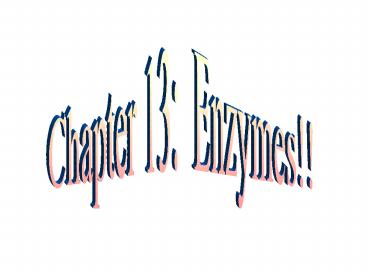Chapter 13: Enzymes!! - PowerPoint PPT Presentation
1 / 32
Title:
Chapter 13: Enzymes!!
Description:
Enzymes receive 'common' names reflecting their function, either in the forward ... Enzymes often require the participation of other small molecules to carry out a ... – PowerPoint PPT presentation
Number of Views:90
Avg rating:3.0/5.0
Title: Chapter 13: Enzymes!!
1
Chapter 13 Enzymes!!
2
What are enzymes?
- Usually proteins (exception ribozymes)
- Biological Catalysts
- Facilitate reactions under physiological
conditions that would require very harsh
conditions in the laboratory
3
Enzymes biological catalysts responsible for
supporting almost all of the chemical reactions
that maintain organismall homeostasis. The
macromolecular components of almost all enzymes
are composed of protein, except for a class of
RNA modifying catalysts known as ribozymes.
Ribozymes are molecules of ribonucleic acid that
catalyze reactions on the phosphodiester bond of
other RNAs. Almost every significant life
process is dependent on enzyme activity.
4
Stryer Fig. 8.3
5
(No Transcript)
6
Functions of Catalysts
- Lower the Ea for a reaction
- Are regenerated
- Do not affect equilibrium position
7
Table 13-3 Enzyme Classification According to
Reaction Type.
Page 470
8
Figure 13-1 An enzymesubstrate complex
illustrating both the geometric and the physical
complementarity between enzymes and substrates.
Page 460
9
Number Classification Biochemical Properties
1. Oxidoreductases Act on many
chemical groupings to add or remove hydrogen
atoms. 2. Transferases Transfer functional
groups between donor and acceptor
molecules. Kinases are specialized transferases
that regulate metabolism by transferring
phosphate from ATP to other molecules. 3. Hydr
olases Add water across a bond, hydrolyzing
it. 4. Lyases Add water, ammonia or carbon
dioxide across double bonds, or remove these
elements to produce double bonds.
5. Isomerases Carry out many kinds of
isomerization L to D isomerizations, mutase
reactions (shifts of chemical groups) and
others. 6. Ligases Catalyze reactions in which
two chemical groups are joined (or ligated)
using ATP.
10
(No Transcript)
11
1.Addition or removal of water
a.Hydrolases - these include esterases,
carbohydrases, nucleases, deaminases, amidases,
and proteases b.Hydrases such as
fumarase, enolase, aconitase and carbonic
anhydrase 2.Transfer of electrons
a.Oxidases b.Dehydrogenases
3.Transfer of a radical
a.Transglycosidases - of monosaccharides
b.Transphosphorylases and phosphomutases - of a
phosphate group c.Transaminases - of
amino group d.Transmethylases - of a
methyl group e.Transacetylases - of an
acetyl group 4.Splitting or forming a C-C bond
a.Desmolases 5.Changing geometry or
structure of a molecule a.Isomerases
6.Joining two molecules through hydrolysis of
pyrophosphate bond in ATP or other triphosphate
a.Ligases
12
Oxidoreductases--catalyze redox reactions
Usually require a coenzyme
Ethanol NAD ? Acetaldehyde NADH H
Enzymes receive common names reflecting their
function, either in the forward or reverse
direction.
The enzyme for this reaction is called
Alcohol Dehydrogenase
13
Transferases-transfer functional groups
Kinases transfer phosphates from ATP (or GTP)
E.g Hexokinase Glucose ATP ?glc-6-P ADP
Hydrolases catalyze hydrolytic cleavages
Proteases are hydrolases
14
Lyases catalyze group elimination to form double
bonds
e.g. Enolase (glycolysis)
2-Phosphoglycerate ? H2O phosphoenolpyruvate
Isomerases--duh, interconvert isomers
e.g. phosphoglucose isomerase
Glucose-6-phosphate ? Fructose-6-phosphate
15
Ligases--join to substrates together at the
expense of ATP
e.g. DNA Ligase
Joins Okazaki fragments during DNA replication
Some bacterial ligases substitute NAD as the
energy source.
16
Coenzymes
- Enzymes often require the participation of other
small molecules to carry out a particular
reaction. - These small molecules, called coenzymes, are
metabolic derivatives of vitamins. - Vitamins are nutrients required in small amounts
by organisms. Vitamin deficiencies usually
present as metabolic disorders, e.g. scurvy
17
Table 13-1 The Common Coenzymes.
18
Table 13-2 Vitamins That Are Coenzyme Precursors.
Page 464
19
Figure 13-2 The structures and reaction of
nicotinamide-adenine dinucleotide (NAD) and
nicotinamide adenine dinucleotide phosphate
(NADP).
Page 461
20
Figure 13-4 Structures of nicotinamide and
nicotinic acid.
Page 464
21
Enzyme Activities Are Regulated at Various Levels
- Transcription
- Processing
- Translation
- Post-translational modification
- Transient modification (e.g. phosphorylation)
- Allosteric Effectors
22
Figure 13-5 The rate of the reaction catalyzed by
ATCase as a function of aspartate concentration.
Page 465
23
Figure 13-6 Schematic representation of the
pyrimidine biosynthesis pathway.
Page 466
24
Figure 13-7a X-Ray structure of ATCase. (a)
(left) T-state ATCase along the proteins
molecular threefold axis of symmetry (right)
R-state ATCase along the proteins molecular
threefold axis of symmetry.
Page 467
25
Figure 13-7b X-Ray structure of ATCase. (b)
(left) T-state ATCase along the proteins
molecular twofold axis of symmetry (right)
R-state ATCase along the proteins molecular
twofold axis of symmetry.
Page 467
26
Figure 13-8 Comparison of the polypeptide
backbones of the ATCase catalytic subunit in the
T state (orange) and the R state (blue).
Page 468
27
Figure 13-9 Schematic diagram indicating the
tertiary and quaternary conformational changes in
two vertically interacting catalytic ATCase
subunits.
Page 469
28
(No Transcript)
29
(No Transcript)
30
Styer p.277
31
Stryer p. 278
32
(No Transcript)































